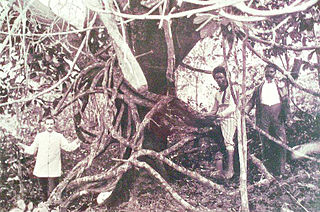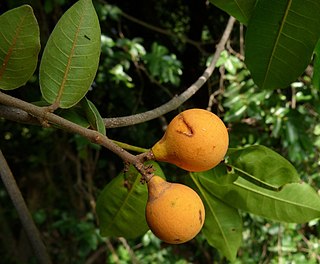
Trachelospermum jasminoides is a species of flowering plant in the family Apocynaceae, native to eastern and southeastern Asia. Common names include Confederate jasmine, star jasmine, Confederate jessamine, and Chinese star jessamine.
Landolphia kirkii is a species of liana from the family Apocynaceae that can be found in Democratic Republic of the Congo, Malawi, Mozambique, Tanzania, Zambia, Zimbabwe, and in the KwaZulu-Natal province of South Africa.

Adenorandia is a monotypic genus of flowering plants in the family Rubiaceae. It was described by Vermoesen in 1922. The genus contains only one species, viz. Adenorandia kalbreyeri, which is found from west-central tropical Africa.

Picralima is a plant genus in the family Apocynaceae, first described as a genus in 1896. It contains only one known species, Picralima nitida, native to tropical Africa.

Landolphia is a genus of flowering plants in the family Apocynaceae first described as a genus in 1806. They take the form of vines that scramble over host trees. Landolphia is native to tropical Africa.

Landolphia owariensis is a species of liana from the family Apocynaceae found in tropical Africa. Latex can be extracted from this plant for the manufacture of natural rubber. Other names for this vine are eta, the white rubber vine and the Congo rubber plant. Congo rubber was a commercial rubber exported from the Congo Free State starting in 1890, most notable for its forced harvesting under conditions of great human suffering, in the Congo Free State, detailed in the 1904 Casement Report. From 1885 to 1908, millions died as a result of murder, deprivation, and disease, with population falling by millions in this period; some writers estimate this loss to be as high as 10 million people.
Strychnos icaja is a species belonging to the plant family Loganiaceae, native to West Tropical Africa. It is a very large, tropical rainforest liana which may attain a length of 100 m (330 ft).

Annickia affinis is small to medium sized tree that grows up to 30m tall, it belongs to the Annonaceae family. Also known as the African yellow wood, it is widely used in Central Africa and parts of West Africa in the treatment of various diseases. Both Annickia affinis and Annickia chlorantha are widely studied and sometimes credited with the name Enantia chrlorantha.

Alstonia congensis, is a tree within the Apocynaceae family and one of two African species within the Alstonia genus, the other being the Alstonia boonei De Wild. Both have similar morphological characteristics.

Pericopsis laxiflora is a woody deciduous shrub or tree within the Fabaceae family. Sold commercially as satin wood, it is known in some regions as Kulu Kulu, among the Hausa speaking people, it is called Makarfo, the Yorubas call it Ayan and the Igbos call it Abua-Ocha. It is one of three species in the genus Pericopsis genus that occurs in Africa.
Funtumia africana is a tree within the family Apocynaceae, it is one of two species within the genus Funtumia.

Landolphia heudelotii is a climbing shrub or liana that is within the Apocynaceae family, it occurs in the Guinea and Sudan savannahs of West Africa and cultivated for its rubber and edible fruit.
Landolphi mannii is a liana within the dogbane family (Apocynaceae). It is commonly called Jungle chocolate or Malombo. Its fruit, with significant lipid and iron content is consumed by locals and it is also a part of the diet the Mandrillus sphinx.
Landolphia angustisepala is a species within the Apocynaceae family. It occurs in Gabon and the Democratic Republic of the Congo.
Landolphia dulcis is a climbing shrub or liana within the Apocynaceae family.

Gardenia erubescens is a shrub or small tree species with edible fruits that occurs in the Guinea and Sudan savannah vegetation of West and Central Africa. It is within the Rubiaceae family.
Hugonia planchonii is a liana with bright yellow flowers that are short-lived and stems producing alternate hooks that is endemic to countries in Tropical West Africa but also occurs in Cameroon and Gabon. It is within the Linaceae family.

Berlinia grandiflora is a small to medium sized tree found in the West and West Central African region along riparian habitats or gallery forests habitat types.

Ficus laurifolia is an hemi-epiphytic species that sometimes grows as a shrub or liana or as a tree, the species is within the family Moraceae.
Albizia chevalieri is a shrub or small tree within the family Fabaceae. It is native to West Africa and parts of Central Africa and is found in the drier parts of the savanna.











